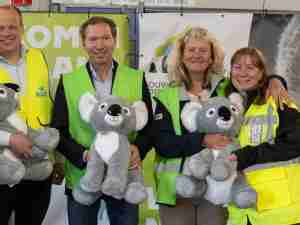China may be the big focus for air carriers these days, yet Australia and New Zealand are proven niche markets for Qantas and Air New Zealand. These carriers continue to expand services, upgrade fleets, and expand global reach.
Air New Zealand is an international and domestic airline group that provides air passenger and cargo transport services within New Zealand, as well as to and from Australia, the South West Pacific, Asia, North America and the United Kingdom. Air New Zealand offers both freighter and passenger aircraft cargo services utilizing one airplane with two rotations a week.
"We fly a freighter out of the United States on Thursdays and Sundays," explains Sal Sanfilippo, North American director for Air New Zealand Cargo from his Los Angeles office.
The service operates on a wet lease basis with Atlas Air. The 747-400 freighter circles the globe twice weekly with service to Frankfurt, Chicago, Honolulu (a tech stop), Auckland, Melbourne, Shanghai and back to Frankfurt.
Expanded US reach
Regular passenger service is offered from the US West Coast via San Francisco (SFO) and Los Angeles (LAX). Over two years' time, service on the San Francisco-Auckland route has been expanded from three flights per week to daily service.
"This was very exciting for New Zealand and the marketplace. It was a big deal for us," says Sanfilippo. "San Francisco was the first new US origin for us in a long time. We were also the first new international carrier to offer flights out of San Francisco in several years after the fall off from 9-11. SFO Airport was great to work with in making this new origin a reality. They were very accommodating in working with us to expand our routes."
Los Angeles (LAX) continues to operate as the carrier's hub, and it is there that Air New Zealand maintains its regional offices. From LAX double daily non-stop flights fly to Auckland and onward to Australia. Four flights a week are also offered to key islands in the Pacific.
"From a passenger airline perspective, we have a nice balance of freight coming in and out of these markets," Sanfilippo states. "Our flights to New Zealand have experienced steady demand and are full."
While trade imbalances exist between the United States and New Zealand, the economies are similar in that both countries buy the same types of commodities. Consequently, shipments such as seasonal perishables are a big commodity flying between the two markets.
"We wouldn't fly produce on the freighter because people will not pay freighter rates," he says. "But for line-flights, the Australians and New Zealanders are, in their Winter season, willing to pay for American produce; just as we are willing to pay for their produce during our Winter season."
Sanfilippo adds that to make the freighter service economical, it must fly around the world and into Asia to get multiple sectors on the rotation with heavy loads.
Fleet upgrades
In recent years, Air New Zealand has been making investments to upgrade its fleet. "We made a major investment in B777s, which has been extremely successful," he says. "These are very efficient aircraft both for passengers and cargo."
This month Air New Zealand will be getting its eighth B777 delivered. Eight B787s are on order.
Air New Zealand is the launch customer for Boeing's 787-9 aircraft, with the first aircraft due to be introduced into service in 2011 and the last of the eight aircraft purchased to date being delivered in 2013.
'We also have eight 747-400s, many A320s and are slowly retiring a shrinking number of 767s,' Sanfilippo says.
The carrier is now operating primarily A320s on its short haul routes, between New Zealand, Australia, and the Pacific Islands.
Corporate executives view the new aircraft as providing Air New Zealand with a solid platform from which to realize its growth ambitions over the next decade. Air New Zealand is committed to launching at least one new international route every year and it expects t










